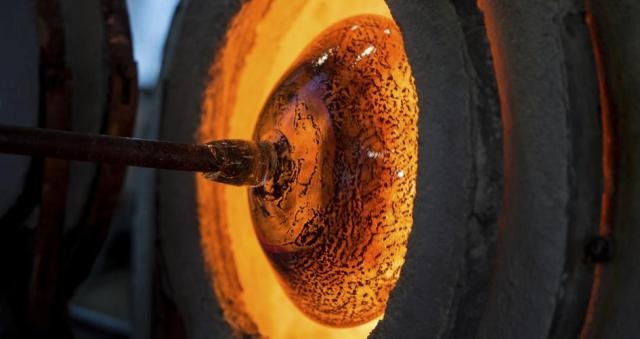Jul 14 2016
The most ordinary phenomena in science can appear to be extremely mysterious. For instance, glass is developed by cooling a liquid quickly until it solidifies. Questions arise from this, such as, how the change takes place; at what point does liquid becomes solid; and whether a definite transition exists at all.
 Prof. Sidney Nagel leads an international collaboration with the Simons Foundation to better understand the qualities of glassy states. (Credit: Copyright Getty Images)
Prof. Sidney Nagel leads an international collaboration with the Simons Foundation to better understand the qualities of glassy states. (Credit: Copyright Getty Images)
The answers to these questions would have implications that go much beyond the physics of glass, in domains as far flung as biology, astrophysics and computer science. Sidney Nagel, the Stein-Freiler Distinguished Service Professor of Physics at the University of Chicago, expects to discover them.
Nagel heads the Simons Collaboration on Cracking the Glass Problem, a team of 13 researchers from seven European institutions and five other U.S. universities financially supported by the Simons Foundation through the Collaborations in Mathematics and Physical Sciences program. The collaboration is supported by a $10 million grant from the Simons Foundation and plans to enhance modern theoretical advances to accomplish a basic and unified understanding of the glass transition.
This is a problem that has been plaguing physics and chemistry for a long, long time. People have made inroads. But we now have different techniques, looking from different points of view, which we think will be able to bring things to a point where we’ll be able to solve something concretely about this glass transition problem.
Sidney Nagel, Professor of Physics, University of Chicago
Edward “Rocky” Kolb, dean of the Division of the Physical Sciences, revealed that the Simons Foundation is recognized for assisting discovery-driven science that aims at obtaining a better understanding of theoretical problems that are fundamentally and scientifically important.
Deceptively complicated
We are grateful to the Simons Foundation for backing this remarkable team that Sid Nagel has assembled. We need just such a team if we hope to see our way through into exactly what endows the glassy state of matter with its curious properties—a more deceptively complicated problem than one might imagine.
Edward Kolb, Dean of the Division of the Physical Sciences, University of Chicago
Two specific properties of glass make it challenging for theorists. Unlike other crystalline solids and metals, its atoms are not organized in an orderly periodic lattice, instead they are an unorganized array. “Physics is not yet very good at understanding things that are disordered,” said Nagel.
Glass is far from what physicists refer to as thermal equilibrium, and even this is difficult to be addressed by physics even though scientists are more concerned in behavior that exists in systems and not in equilibrium including the weather, the cooling of the universe following the Big Bang, and the folding of proteins. Identifying a technique that helps in the formation of glass paves way to perceive other phenomena, Nagel added.
“Far-from-equilibrium behavior is, to me, the most exciting and deepest question in science today,” he said.
Energy landscape
Researchers need to record every possible state that the system can occupy any time in order to perceive the transition of glass from liquid to solid, and they refer to this as an “energy landscape.” If one particle sits at point A rather than at B, the entire landscape changes since that particular particle communicates with the others in the system. There are millions of particles when forming a glass, and the energy landscape becomes uneven when each particle is capable of moving in three dimensions. Mathematical description becomes almost abnormal and obtaining an accurate solution also becomes impossible.
Nagel approached this problem by analyzing a simplified case in which there were no atoms moving as the glass was held at absolute zero. This approach did not suit real-world temperatures, but Nagel and his team illustrated a clean and precise transition to a rigid solid.
Pretty far from useful, but if you know something is exact at some point, you can start at that point and work away from it.
Sidney Nagel, Professor of Physics, University of Chicago
In the meantime, researchers from Europe were addressing the problem from a different angle. The researchers identified a clear transition for a theoretical glass where each particle existed in an infinite number of dimensions.
Although both approaches were entirely different they produced similar mathematical results in certain areas where they overlapped. The teams decided to work together in order to provide a realistic picture of what takes place in three dimensions at normal temperatures. Both the approaches were brought together by a third group analyzing the dynamics of low-temperature liquids.
Nagel expects this work to develop a method that will help solve other issues, both unknown and known, with uneven energy landscapes
People use energy landscapes in many scientific contexts. What we have with the glass problem is the progenitor of all landscape pictures. What we’re able to do with this very concrete problem is to say some specific things about how to treat a landscape of this kind that is not possible in those other contexts. And you hope that this understanding can be disseminated to other areas which you originally thought were not related at all.
Sidney Nagel, Professor of Physics, University of Chicago